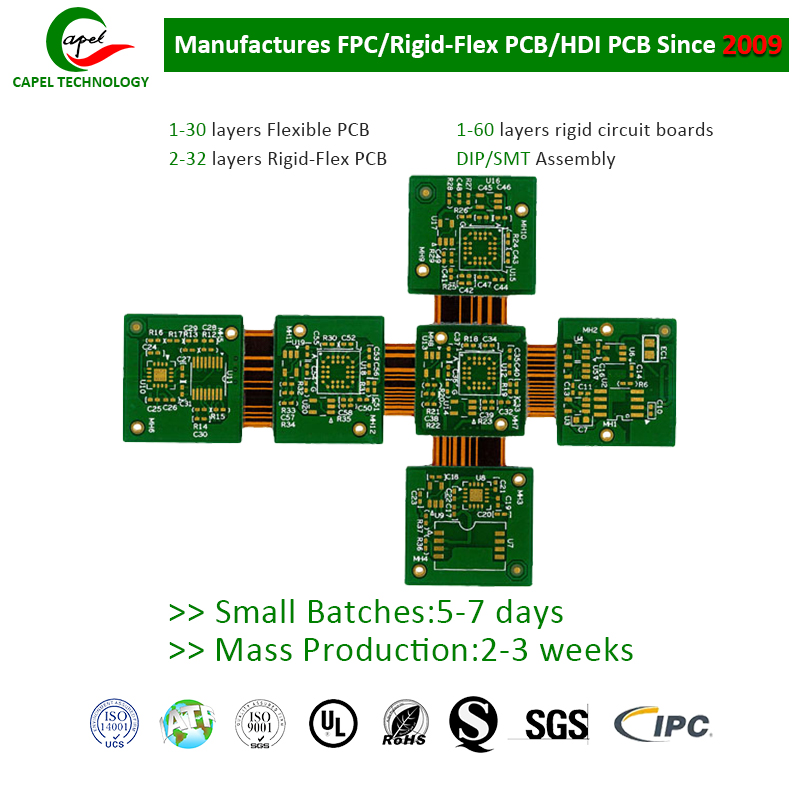How to choose damping and vibration reduction materials suitable for 14-layer flex pcb to prevent the impact of mechanical vibration and impact on the circuit board?
Introduce:
As technology advances and electronic devices continue to shrink in size, the importance of vibration and shock protection for circuit boards has increased significantly. A robust and reliable 14-layer flexible PCB is critical for a variety of applications, and to achieve this, choosing the right damping and vibration-absorbing materials is crucial. In this blog, we’ll look at the factors to consider when choosing such materials and how they protect against the harmful effects of mechanical vibration and shock on circuit boards.
The importance of damping and vibration-reducing materials:
Mechanical vibration and shock can have serious consequences on the functionality and reliability of a 14-layer flexible PCB. These vibrations can stress components, causing solder joints to break, electrical shorts, or even complete circuit board failure. To ensure PCB longevity and performance, it is critical to select appropriate damping materials that can absorb or dissipate the energy generated by vibration and shock.
Factors to consider:
1. Frequency range:
The first factor to consider is the frequency range of vibrations to which the PCB is exposed. Different materials are good at absorbing vibrations in specific frequency ranges. Therefore, it is important to determine the dominant frequency and select the damping material accordingly. A thorough analysis of the expected vibration spectrum will help select the correct material that will effectively attenuate the vibrations.
2. Material properties:
Various materials have different damping properties, and it is critical to select materials that meet the specific requirements of a 14-layer flexible PCB. Some common damping materials include elastomers, viscoelastic polymers, foams, and composites. Each material has its own unique properties, such as stiffness, viscoelasticity, and energy absorption capabilities. Understanding these characteristics and their impact on vibration damping capabilities is critical to making the right choice.
3. Environmental considerations:
The work environment plays an important role in selecting the appropriate damping material. Factors such as temperature changes, humidity levels and exposure to chemicals can all affect the performance of damping materials. It is important to evaluate the environmental conditions in which a 14-layer flex PCB will operate and select a material that can withstand these conditions without affecting its damping capabilities.
4. Flexibility and compatibility:
Since we are dealing with a 14-layer flexible PCB, the selection of damping materials should also consider the flexibility and compatibility of the flexible substrate. The material should not impede the flexibility of the PCB and must adhere firmly to its surface. It is recommended to perform compatibility testing to ensure that the selected damping material does not interfere with the functionality of the flexible PCB.
Prevent the impact of mechanical vibration on circuit boards:
1. Correct installation techniques:
In addition to using damping materials, proper mounting techniques are critical to preventing the effects of mechanical vibration on the circuit board. Securely mounting the PCB to its enclosure or anti-vibration mounting platform helps reduce the transmission of vibration to the board. Properly designed mechanical supports and fixtures ensure that the PCB remains stable even under external vibration or shock.
2. Component selection:
Choosing strong, reliable components that can withstand vibration and shock is another important consideration. Components with built-in shock and vibration resistance, such as reinforced solder joints or elastomeric encapsulation, can significantly enhance the overall resilience of a circuit board. It is critical to work with your parts supplier to select rugged components suitable for the expected vibration loads.
3. Strict testing:
Finally, it is necessary to rigorously test the 14-layer flexible PCB at the component and system levels to ensure its ability to withstand vibration and shock. Exposing circuit boards to representative mechanical vibration conditions and monitoring their performance is critical to verifying the effectiveness of selected damping and vibration reduction materials.
In conclusion:
Selecting appropriate damping and vibration-reducing materials is crucial to prevent the impact of mechanical vibration on a 14-layer flexible PCB. Considering factors such as frequency range, material properties, environmental conditions, flexibility and compatibility can help make an informed decision. Additionally, using correct mounting techniques, selecting rugged components, and conducting rigorous testing are important steps to ensure the board’s resilience and reliability against mechanical vibration and shock. By taking these measures, the functionality and service life of the PCB can be guaranteed, thereby improving the overall performance of the electronic device.
Post time: Oct-04-2023
Back







